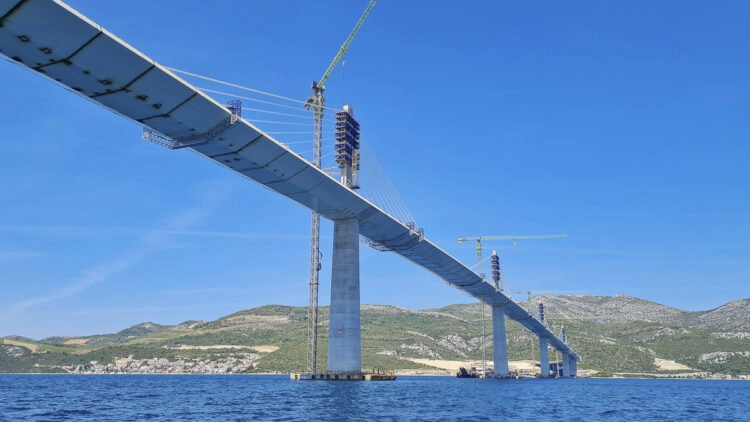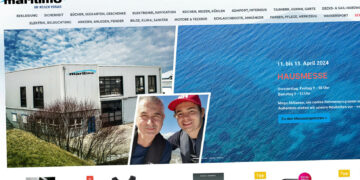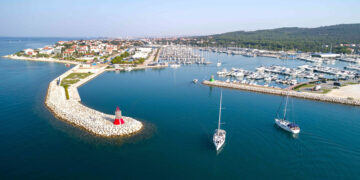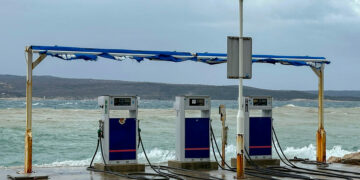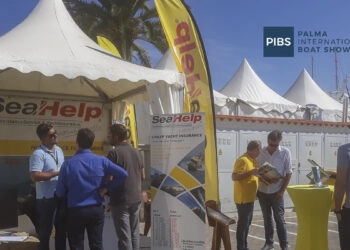Since Croatia’s accession to the EU on July 1, 2013, a solution for the traffic problem due to the Neum Corridor has been feverishly sought. Instead of a ferry connection or a transit highway through the Neum Corridor without border controls and entry to Bosnia and Herzegovina, Croatia decided to build the Pelješac Bridge. Construction started in 2007, but was halted in 2010 for financial reasons. In July 2018, construction work continued. Now, exactly four years later, the Pelješac Bridge is scheduled to be opened to traffic at the end of July 2022.
The Pelješac Bridge (Pelješki most in Croatian) is scheduled to bridge the Mali Ston Bay from July 2022 after the last four years of construction (seven years in total), thus connecting Dubrovnik-Neretva County with the rest of Croatia, bypassing the Neum Corridor.
At least, that is what Croatian Transport Minister Oleg Butković said during a visit to the bridge on May 27, 2022, according to a report by Adriatic news portal Morski.hr, when he joined Joško Cebal, deputy prefect of Dubrovnik-Neretva County, President of the Croatian Road Administration Josip Škorić and project manager Goran Legco to personally inspect the successful completion of construction work.
The bridge is finished, Transport Minister Butković said during a visit in late May
“The bridge is finished,” Butković noted happily afterwards, and as for the rest, “that is, the access roads,” one could “say at the moment that at the end of July the Pelješac Bridge could be opened” with part of the access roads, “more precisely, the second and third phases of the project.”
Specifically, he said, these are a total of 25 kilometers of access roads that would lead from Duboka to Sparagovic and from Sparagovic to Prapratno.
The Neum corridor is an access road of the state of Bosnia and Herzegovina to the Adriatic port of Neum, about five kilometers wide at its narrowest point. The problem: it is completely surrounded by Croatian territory (Dubrovnik-Neretva County).
The problem: the so-called Neum corridor is completely surrounded by Croatian territory
Already in the late Middle Ages, the area around Neum had caused dispute between the republics of Venice and Ragusa because of its exposed location; in 1699, the strip of land became part of the Ottoman Empire, partly because the Republic of Ragusa wanted to prevent further strengthening of Venice in the region. Later, the disputed strip of land became part of Herzegovina.
Currently, people traveling through Croatia on their way south have to cross a few kilometers of Bosnian-Herzegovinian territory near the town of Neum and have to cross an external EU border twice with the corresponding personal and customs controls. In addition to the tourist area, this affects transit traffic extremely disadvantageously, as the controls take a lot of time.
With the time-consuming border controls should now in a few weeks finally be an end
Now in a few weeks, this should finally come to an end: from the end of July, according to statements by the Croatian Minister of Transport, the two-lane extradosed bridge in the south of Croatia will be ceremoniously opened and will bridge the bay of Mali Ston, the wait at the border control points will then be over.
An extradosed bridge is the name given to a comparatively new design of prestressed concrete bridge in which the tendons pass over a low pylon outside the cross-section of the deck girder, thus combining the load-bearing characteristics of a cable-stayed bridge and a beam bridge. The name is originally derived from the French term “extrados” meaning “arched bridge,” which has been adopted into English.
The bridge will be integrated into the A1 freeway, which is planned to run as far as Dubrovnik by 2029
After an aborted initial project, construction of the bridge began on July 30, 2018, and the last segment of the deck girder was lifted into place and welded on July 28, 2021; the following night, the gap closure was celebrated with a large fireworks display. The bridge is now to be integrated into the A1 highway, the construction of which is to continue from Metković to Osojnik near Dubrovnik from 2024 to 2029.
In addition, the bridge is expected to facilitate access to the islands in southern Croatia, thus contributing to the revitalization of the Pelješac and Neretva area and counteracting negative demographic trends. In particular, the population on the islands of Korčula, Lastovo and Mljet, but also the population of Dubrovnik, expects the construction of the Pelješac Bridge to provide better connections to the mainland and other Croatian cities.
The new bridge connects Komarna on the mainland with the Pelješac peninsula near Brijesta
Specifically, the bridge connects the town of Komarna on the mainland with the Pelješac peninsula near Brijesta. Currently, an alternative ferry connection, which is very busy in the summer months, runs from Ploče to Trpanj on the Pelješac peninsula. On Pelješac, a new trunk road of about 30 km is being built as a future part of the Državna cesta D8, which will lead traffic from the bridge to the current D8.
Built by the China-subsidized China Road and Bridge Corporation following a 2018 decision by the Hrvatske ceste. The construction was considered challenging, as some of the bridge piers could only be founded at a depth of more than 100 meters.
The area is also known for bora with violent storms. Finally, the bay of Mali Ston with its clear waters and large oyster breeding grounds is a special nature reserve.
The bridge’s foundations rest on steel bored piles up to 124 meters long
The bridge is a total of 2, 4 kilometers long and 22.5 meters wide. It has a 3.40-meter-wide median separated by guardrails that will house the pylon stems and stay cable anchorages.
The lanes are to be divided into a 3.50-meter-wide traffic lane, a 2.50-meter-wide emergency lane and two safety lanes, each one meter wide. Two high windbreak fences will be installed on the 1.55-meter-wide raised outer edge strips to keep the bridge passable during storms. The bridge has 13 openings, whose largest pier center-to-center distance is 285 meters.
It has 6 pylons and 7 piers made of reinforced concrete. The pylon stems are between 82.5 and 98 meters high in total and overhang the roadway by a full 40 meters. Their foundations rest on steel bored piles up to 124 meters long. At the level of the water surface, widenings have been installed as ship deflectors, i.e. devices designed to prevent ships, especially ocean-going vessels, from hitting the bridge piers.
Minister Butković: Despite market disruptions and rising prices, nothing will be questioned
Contractors had to “work under difficult conditions financially due to market disruptions and rising prices,” Minister Butković said appreciatively during his visit. Nevertheless, “nothing is in question” with regard to the bridge project, he added.
Originally, the cost of the Pelješac Bridge had been estimated at around 420 million euros. In June 2017, the European Union had announced that it would cover 85 percent of the construction costs.
The Zagreb-based news portal Vecernji.hr states that the total cost of the project for the construction of the bridge and the access roads would now be “between 100 and 150 million kuna” (13.27 and 19.91 million euros, respectively) higher than planned as a result. According to the report, the total cost would currently amount to four billion kuna (more than half a billion euros); it was not yet known whether the difference would also be paid from EU funds or by the Republic of Croatia.
Peljesac bridge has passed a technical inspection and opening is expected in July

Mit dem Laden des Videos akzeptieren Sie die Datenschutzerklärung von YouTube.
Mehr erfahren


